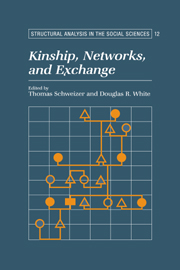Book contents
- Frontmatter
- Contents
- Preface
- List of contributors
- 1 Revitalizing the Study of Kinship and Exchange with Network Approaches
- I Representing Kinship Dynamics, Material Flow, and Economic Cooperation
- II Individual Embeddedness and the Larger Structure of Kinship and Exchange Networks
- 6 Experiential Flexibility of Cultural Models: Kinship Knowledge and Networks among Individual Khasi (Meghalaya, N.E. India)
- 7 Moral Economy and Self-interest: Kinship, Friendship, and Exchange among the Pokot (N.W. Kenya)
- 8 Risk, Uncertainty, and Economic Exchange in a Pastoral Community of the Andean Highlands (Huancar, N.W. Argentina)
- III Marriage, Exchange, and Alliance: Reconsidering Bridewealth and Dowry
- IV Emergence, Development, and Transformation of Kin-Based Exchange Systems
- Index
6 - Experiential Flexibility of Cultural Models: Kinship Knowledge and Networks among Individual Khasi (Meghalaya, N.E. India)
Published online by Cambridge University Press: 05 November 2011
- Frontmatter
- Contents
- Preface
- List of contributors
- 1 Revitalizing the Study of Kinship and Exchange with Network Approaches
- I Representing Kinship Dynamics, Material Flow, and Economic Cooperation
- II Individual Embeddedness and the Larger Structure of Kinship and Exchange Networks
- 6 Experiential Flexibility of Cultural Models: Kinship Knowledge and Networks among Individual Khasi (Meghalaya, N.E. India)
- 7 Moral Economy and Self-interest: Kinship, Friendship, and Exchange among the Pokot (N.W. Kenya)
- 8 Risk, Uncertainty, and Economic Exchange in a Pastoral Community of the Andean Highlands (Huancar, N.W. Argentina)
- III Marriage, Exchange, and Alliance: Reconsidering Bridewealth and Dowry
- IV Emergence, Development, and Transformation of Kin-Based Exchange Systems
- Index
Summary
INTRODUCTION
For many years, social anthropologists have observed a gulf between the way peoples say kin should act toward one another – ideal standards or norms – and what they actually do…. What, then, to do conceptually about this apparent gulf between the ideal and the actual?
More than two decades ago, this question was asked by the late Roger M. Keesing in his textbook, Kin Groups and Social Structure (1975:122). He sketched out two lines of thinking, providing insights on how to deal with the problem: The first placed emphasis on “the actual,” focusing on individual interests and strategies for goal attainment and analyzing interpersonal relations and informal networks; the second line of thinking laid stress upon “the ideal,” investigating kinship in terms of people's own conceptual and symbolic world (1975:122–31).
In the following years the relationship between ideal standards or norms and actual kinship practices remained “a thorny question” (Barnard & Good 1984: 162). Whereas the first line of thinking has evidently produced some more food for thought (see, e.g., Bourdieu 1977; Holy 1986; Holy & Stuchlik 1983), the second does not appear to have had much to offer. On the one hand, symbolic analyses of kinship – especially those which followed and developed Schneider's approach (e.g., Delaney 1991; Inden & Nicholas 1977; Schneider 1968) – have been criticized for providing little evidence of links between allegedly culturally dominant indigenous concepts and symbols and specific “native voices.” The relationship between such cultural constructs and human action remains more or less unaddressed, and intracultural variations are neglected (Barnard & Good 1984:180; Starr 1994:229).
- Type
- Chapter
- Information
- Kinship, Networks, and Exchange , pp. 113 - 136Publisher: Cambridge University PressPrint publication year: 1998



